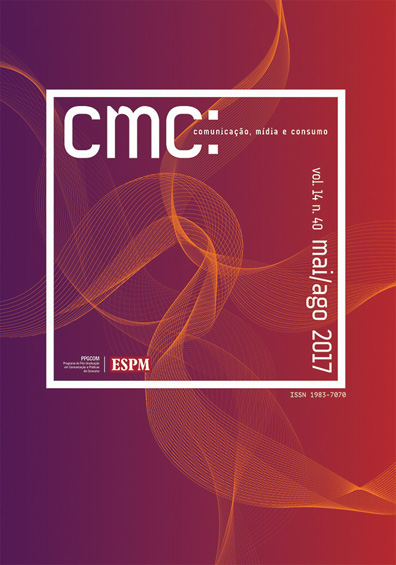The X-Files: uma análise das estratégias de social TV do perfil @thexfiles
DOI:
https://doi.org/10.18568/cmc.v14i40.1378Palavras-chave:
Social TV, Televisão, Twitter, The X-FilesResumo
A social TV marca a convergência da experiência televisiva com as novas mídias. O fenômeno se refere ao compartilhamento de conteúdos por intermédio das redes sociais e dos aplicativos de segunda tela de maneira síncrona ao fluxo televisivo. A partir desse contexto, este artigo tem o objetivo de refletir sobre as ações de social TV adotadas pela Fox durante a 10ª temporada de The X-Files. Analisamos as postagens da página (@thexfiles) gerenciada pelo canal no Twitter a fim de entender como contribuem para o aprofundamento e a compreensão do universo ficcional da série. Concluímos que as estratégias de engajamento da emissora reforçam o laço social, estimulam a participação dos telespectadores interagentes e ampliam os arcos narrativos de The X-Files.
Downloads
Referências
Análise Social TV. OBSERVATÓRIO DA QUALIDADE DO AUDIOVISUAL, 2015-2016. Disponível em: http://observatoriodoaudiovisual.com.br/resultados/social-tv/analise-2/.Acesso em: 18 mar. 2017.
ANDERSON, Benedict. Comunidades Imaginadas - reflexões sobre a origem e a difusão do nacionalismo. São Paulo: Companhia das letras, 2008.
BRANDÃO, Maria Cristina; BORGES, Gabriela; SIGILIANO, Daiana. et.al . Cultura participativa na esfera ficcional de O Rebu. In: LOPES, Maria Immacolata Vasallo (Org.). Por uma teoria de fãs da ficção televisiva brasileira. 1. ed. Porto Alegre: Sulina, 2015.
BENNETT, Tara. Showrunners: the art of running a TV show. London: Titan Books, 2014.
BENTON, Adrian; HILL, Shawndra.The Spoiler Effect? Designing Social TV Content That Promotes Ongoing WOM. Conference on Information Systems and Technology, Arizona, 2012.
BORGES, Gabriela; SIGILIANO, Daiana. Television dialogues in Brazilian
fiction: Between production and consumption. In Applied Technologies and Innovations, v.12, n.2, p.54-68, 2016. Disponível em: https://academicpublishingplatforms.com/article.php?journal=ATI&number=20&article=2288. Acesso em: 21 mai. 2017
BRANDÃO, Maria Cristina; BORGES, Gabriela; SIGILIANO, Daiana. et al . Cultura participativa na esfera ficcional de O Rebu. In: LOPES, Maria Immacolata Vasallo (Org.). Por uma teoria de fãs da ficção televisiva brasileira. 1. ed. Porto Alegre: Sulina, 2015.
CANNITO, Newton. A televisão na era digital – interatividade, convergência e novos modelos de negócio. São Paulo: Plexus, 2010.
CARTER, Chris. Arquivo X - Uma série de casos. Manaus, TwentiethCentury Fox Television, 2016. 3 discos/ NTSC, color, Dolby Digital 5.1.
CLARKE, Michael. Lost and Mastermind Narration. In Television New Media, v. 11 n. 2, 2010, p.123-142. Disponível em: http://journals.sagepub.com/doi/pdf/10.1177/1527476409344435. Acesso em: 9 jan. 2017.
COLLETTI; Giampaolo; MATERIA, Andrea. Social TV Guida alla nuova TV nell’era di Facebooke Twitter. Milano: Gruppo24Ore, 2012.
FECHINE, Yvana. TV Social, práticas interacionais e modos de presença: contribuição para a delimitação do conceito. XXV Encontro Anual da Compós, Anais...Goiânia, 2016. Disponível em: http://www.compos.org.br/biblioteca/pdfformatsite_3428.pdf. Acesso em: 10 mar. 2017.
FOUTCH, Haleigh. Comic-Con 2013 | Painel - 20 anos de Arquivo X. Omelete, 2013. Disponível em: https://omelete.uol.com.br/series-tv/artigo/comic-con-2013-painel-20-anos-de-arquivo-x/. Acesso em: 15 mar. 2017.
JOHNSON, Catherine. Quality/Cult Television: The X-Files andTelevisionHistory. HAMMOND, Michael; MAZDON, Lucy (Orgs.). The Contemporary Television Series. Edinburgh : Edinburgh University Press. p.57-74, 2005.
JOST, François. Novos comportamentos para antigas mídias ou antigos comportamentos para novas mídias? In Revista Matrizes, São Paulo, v.4 n.2, p. 93-109, 2011. Disponível em:www.revistas.usp.br/matrizes/article/download/38294/41119. Acesso em: 2 mar. 2017.
MITTELL, Jason. Television and American Culture. New York: Oxford University Press, 2010.
PORTER, Bartley; PORTER, Lynnette. The Adventures of Brisco County. LAVERY, D. (Org.).The Essential Cult TV Reader. Kentucky: University Press of Kentucky,p.15-21 ,2010.
PRIMO, Alex. Quão interativo é o hipertexto? : Da interface potencial à escrita coletiva. In Fronteiras: Estudos Midiáticos, São Leopoldo, v. 5, n. 2, p. 125-142, 2003. Disponível em: http://www.ufrgs.br/limc/PDFs/quao_interativo_hipertexto.pdf. Acesso em: 7 mar. 2017.
PROULX, Mike; SHEPATIN Stacey. Social TV – How marketers can reach and engage audiences by connecting television to the web, social media, and mobile. New Jersey: John Wiley& Sons Inc, 2012.
RECUERO, Raquel. A conversação em rede: comunicação mediada pelo computador e redes sociais na Internet. 2. ed. Porto Alegre: Sulina, 2014.
Rede Globo investe em ação inédita para estimular o backchannel do The Voice Brasil . OBSERVATÓRIO DA QUALIDADE NO AUDIOVISUAL, 2015. Disponível: http://observatoriodoaudiovisual.com.br/thevoicebrasilnasocialtv/. Acesso em: 5 mar. 2017.
REEVES, Jimmie L.; RODGERS, Mark C; EPSTEIN, Michael. Rewriting Popularity- The Cult Files. In: LAVERY, David; HAGUE, Angela; CARTWRIGHT, Marla (Orgs.). Deny All Knowledge - Reading the X-Files. New York: Syracuse University Press, p. 22-35, 1996.
Revelando o ambiente Social TV. KANTAR IBOPE MEDIA, Artigos & Papers, 2015. Disponível em: https://www.kantaribopemedia.com/revelando-ambiente-social-tv/. Acesso em: 1 jun. 2017.
SANTAELLA, Lucia; LEMOS, Renata. Redes sociais digitais: a cognição conectiva do Twitter. São Paulo: Paulus, 2010.
SIGILIANO, Daiana; BORGES, Gabriela. A Rede Globo no ecossistema da Social TV: uma análise sobre as postagens do perfil @redeglobo no Twitter. In Revista Intexto, Porto Alegre, n.36, p. 103-120, 2016. Disponível em: http://seer.ufrgs.br/index.php/intexto/article/view/60315. Acesso em: 21 mai. 2017
SIGILIANO, Daiana. SOCIAL TV: o laço social no backchannel de The X-Files. Dissertação de Mestrado. Juiz de Fora: UFJF, 2017.
SILVERSTONE, Roger. Television and Everyday Life. New York: Routledge, 1994.
State of the Media Trends in TV Viewing—2011 TV Upfronts. NIELSEN, 2011. Disponível em: http://www.nielsen.com/content/dam/corporate/us/en/newswire/uploads/2011/04/State-of-the-Media-2011-TV-Upfronts.pdf. Acesso em: 7 mar. 2017.
SUMMA, Giacomo. Social TV: the future oftelevision in the Internet Age. DSpace@MIT: Massachusetts Institute of Technology, 2011.
TRINTA, Aluízio. Anotações de aula - Estética, Redes e Linguagens, 2015. Disponível em: https://goo.gl/Ic1AAX. Acesso em: 11 mar. 2017.
TV season 2015-2016 in review: thebiggest social TV moments. NIELSEN, 2016. Disponível em: http://www.nielsen.com/us/en/insight/news/2016/tv-season-2015-2016-in-review-the-biggest-social-tv-moments.html. Acesso em: 9 mar. 2017.
WOHN, D. Yvette. History of Social Television. Disponível em: http://yvettewohn.com/2013/01/11/history-of-social-television/. Acesso em: mar. 10 2017
WOLK, Alan. Over the top – How the internet is (slowly but surely) changing the television industry. New York: CreateSpace , 2015.
WOLTON, Dominique. Elogio do grande público - Uma teoria crítica da televisão. São Paulo: Ed. Ática, 1996.
ZUELL, Beatrice; PRERADOVIĆ, NivesMikelić. Methods and usage of sentiment analysis in the context of the TV industry. In Recent Advances in Information Science. Disponível em: http://www.wseas.us/e-library/conferences/2013/Dubrovnik/ECC/ECC-19.pdf. Acesso em: 14 mar. de 2017.







